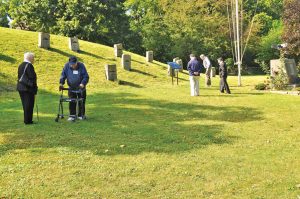TOUCHING THE STONES
By Lookout on Jun 10, 2016 with Comments 0

The Battle of the Atlantic memorial receives a constant flow of visitors. Many are veterans with mobility issues which makes access difficult or limited.
David Lewis, Naval Association of Canada (London) ~
The Battle of the Atlantic Memorial is a tribute to the ships and men of the Royal Canadian Navy, lost in the longest running battle of the Second World War. It is a stunning and moving memorial, created with extreme gratitude for those who made the supreme sacrifice and whose final resting places cannot be marked by graves.
The memorial is built into the grass hillside at HMCS Prevost.
A series of 25 blue granite stones traverse the hillside. Each stone is engraved with the name, the image, the hull number and the date the ship lost during the Battle of the Atlantic.
There is also a stone honouring the sacrifice of the Merchant Navy.
The memorial rests in central Canada as the sailors represented here, who were lost with their ships, came from small towns and large cities, from every province across this great country.
As much as we remember the ships and the gallant names of Valleyfield, Alberni, Louisburg and others, it is not the steel and iron we commemorate.
It is the sons and fathers, the brothers and friends, the grandsons loved and lost. It is their service, their sacrifice that permeates this memorial.
The memorial remembers the 18-year-old sailor bundled heavily against the bitter cold.
He’s standing watch on the open bridge of an RCN Corvette.
Around him is the freezing North Atlantic and in the moonlight are the many plodding hulls of the convoy he’s protecting.
It remembers the blinding flash, being hurled into the air, and slamming down into the icy water.
It remembers the struggle to surface and the weight of the black Arctic water slowly over-whelming. It also remembers the Sunday morning knock on the door, the telegram, the words “deeply regret to inform you…”
If only one ship was lost and only one young Canadian life was given, this memorial would still not be enough to recognize the sacrifice.
There are thousands of other stories that left no community untouched and few families unscarred.
As much as the Battle of the Atlantic Memorial has become a place of remembrance, it has also become a place of healing. It is a destination for those who, for over 70 years, have had no destination. No grave. No marker.
The stones touch those who visit, and those who visit touch the stones.
Two sisters from small town Quebec had their great-granddaughter drive them to HMCS Prevost to visit the memorial.
In November of 1944 their 19-year-old brother was lost with HMCS Shawinigan.
Tears streamed down each face as their aged hands caressed the Shawinigan stone.
There was the elderly gentleman who literally clawed his way up the hill to touch the Regina stone.
He had been on Regina.
The 93-year-old gentleman in a Legion jacket was accompanied by three vans of family members who wanted to see the Spikenard stone.
He had been on another ship in convoy and had witnessed the Spikenard, with his best friend on board, torpedoed and sunk.
With these memories and these visitors in mind, the Naval Association of Canada (London) has launched into an aggressive landscaping project.
Where these visitors once struggled on foot, or walker, or wheelchair to get across the grassy lawn to their memorial, they will now have an even level pathway.
The slippery, dangerous grass hillside is being replaced with a safe solid stairway. It is a huge undertaking but it will truly enhance the accessibility to the site for generations to come.
Standing at the memorial and viewing these granite symbols of sacrifice, the words of Abraham Lincoln come to mind: “We cannot dedicate, we cannot consecrate, we cannot hallow this ground. The brave men, living and dead have consecrated it far above our poor power to add or detract.”
His words ring true today. We do not know what constitutes ‘hallowed’ ground, but we do know that this grassy hillside at HMCS Prevost has changed forever.
Editors Note: The Naval Association of Canada (London) has set up a gofundme page for those who would like to assist them in the dramatic improvements being made at the Battle of the Atlantic Memorial.
The page may be found at www.gofundme.com/battleatlanticmem
Filed Under: Top Stories
About the Author:





